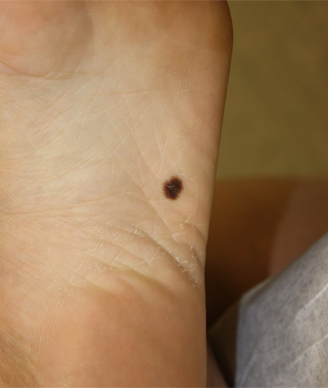History of Prostate Cancer Linked With Risk for Melanoma
Men with a history of prostate cancer may be at increased risk for melanoma, according to data taken from two large cohort studies.
Melanoma with characteristic asymmetry, border irregularity, color variation, and large diameter.

Men with a history of prostate cancer may be at increased risk for melanoma, according to data taken from two large cohort studies. No similar association was found between prostate cancer and other noncutaneous cancers or between melanoma and cancers other than prostate cancer, indicating that this association may not be due to increased medical scrutiny.
“Our finding of prostate cancer diagnosis as a risk predictor for melanoma holds general public health significance, which may inform clinical practice to address the queries and aid the care of patients with prostate cancer,” wrote researchers led by Wen-Qing Li, PhD, of the National Cancer Institute. The results of the study were published in the Journal of Clinical Oncology.
Prior research has linked a personal history of severe acne, a disease with androgen-induced sebum production, to an increased risk for prostate cancer. In addition, studies have shown that people with severe acne were also more likely to have moles and an increased risk for melanoma. Based on this information, Li and colleagues hypothesized that men with prostate cancer may be at increased risk for melanoma based on levels of androgen production.
Li and colleagues conducted a prospective evaluation of 42,372 participants in the Health Professionals’ Follow-Up Study (1986-2010). Patients self-reported prostate cancer, melanoma, or nonmelanoma skin cancer, which was confirmed using pathology reports. During the study period, 539 melanomas and 5,091 prostate cancers were diagnosed.
Men with prostate cancer had a 1.83 increased risk for melanoma diagnosis (95% CI, 1.32-2.54). Men with prostate cancer also had a slightly increased risk for nonmelanoma skin cancers (HR = 1.08; 95% CI, 0.995-1.16); however, the difference in magnitude between risk for melanoma and risk for nonmelanoma cancers was significant (P = .002).
In order to examine if the association might be linked to a detection bias, the researchers also examined whether a history of prostate cancer was linked to other noncutaneous cancers. No association was found. In addition, a history of other noncutaneous cancers did not confer any increased risk for melanoma.
The researchers sought to confirm these findings in a group of 18,603 participants in the Physicians’ Health Study. Once again, data showed that there was an association between prostate cancer and risk for incident melanoma (HR = 2.17; 95% CI, 1.12-4.21).
“The shared etiology might suggest a possible bidirectional relationship between prostate cancer and melanoma; however, we did not observe an increased prostate cancer risk associated with melanoma, which raises a possible concern about the impact of prostate cancer treatment in elevating melanoma risk,” the researchers wrote. Unfortunately, the researchers did not record detailed information on prostate cancer treatment preventing them from examining the effect of different treatments.